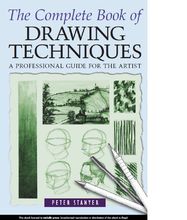

Product Rating
The Complete Book of Drawing Techniques - A professional guide for Artist.
$2.99
$2.99
Drawing, just like writing or speech, is a form of communication, and in the same way as these other forms of communication drawing can be multi-faceted, and very diverse as a means of expression of our observations,
thoughts and feelings. Across the broad field of art and design, artists and designers will use drawing as a specific tool for visual communication, and at the same time use a wide spectrum of drawing techniques to
express, develop, and present their ideas and work to the viewer for what ever reason.
Therefore, it is impossible to make a drawing unless the artist has a clear understanding of the type of drawing that is to be created, and the visual language that is to be used which will give form and
expressive dynamics to the drawing. This is often forgotten or misunderstood by most teachers of drawing.
FIRST ENCOUNTERS WITH DRAWING
Usually our first encounter with drawing is to try to copy something from observation; this could take the form of a portrait, still life, or a landscape. When we’re children we draw our observations from memory, and when we become more life experienced, we tend to draw direct from observation. This is normally when we encounter our first problems with the art of drawing, as we have fixed in our minds that to be successful with
this skill our rendition of what we see must be nothing less than perfect. Usually these students of drawing that have this particular approach, those who seem to be chasing a visual truth through drawing, end up frustrated and feel a sense of failure. We cannot reproduce reality, we can only make a mark or a statement that acts for that reality, or a mark or a statement that best suits our purpose to describe that reality, and this is known as a metaphor. Instead of chasing the idea of truth, what we should be doing is embracing the medium of drawing and using it for a purpose that fulfils our needs as an artist or designer. Let me now explain how we can break down our understanding and use drawing to facilitate our needs. As I have said before there are many reasons for us to want to draw, and there are many techniques and attitudes for us to adopt that will serve our
purpose with the medium of our choice.
What follows is a list of the reasons for us as students or beginners to make drawings.
When using this book you should first identify the reason why you wish or need to do the type of drawing you are going to do, and then turn to the appropriate chapter in the book. That will give you the technique for
the medium, and the knowledge you need to make the drawing.
